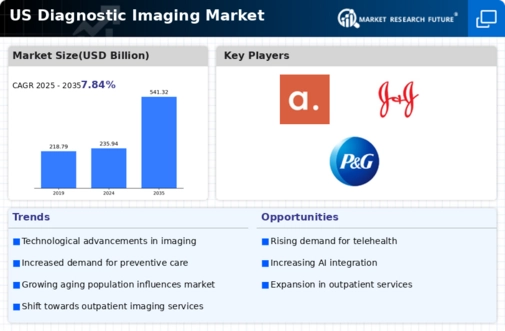Aging Population
The demographic shift towards an aging population in the US significantly influences the diagnostic imaging market. As individuals age, the likelihood of developing health issues increases, leading to a higher demand for diagnostic imaging services. The US Census Bureau projects that by 2030, all baby boomers will be over 65 years old, resulting in a substantial rise in healthcare needs. This demographic trend suggests that the diagnostic imaging market will expand as older adults require more frequent imaging for conditions such as osteoporosis, arthritis, and various cancers. Consequently, healthcare facilities are likely to invest in advanced imaging technologies to cater to this growing segment.
Focus on Personalized Medicine
The growing emphasis on personalized medicine is reshaping the diagnostic imaging market. Tailoring medical treatment to individual characteristics, needs, and preferences requires precise diagnostic tools to inform treatment decisions. Imaging technologies play a vital role in this approach, providing critical insights into patient conditions. As healthcare providers increasingly adopt personalized medicine strategies, the demand for advanced imaging techniques is likely to rise. This trend suggests that the diagnostic imaging market will continue to evolve, with a focus on developing imaging modalities that support personalized treatment plans. The potential for improved patient outcomes through tailored therapies further drives this market forward.
Increased Healthcare Expenditure
Rising healthcare expenditure in the US is a crucial driver for the diagnostic imaging market. As healthcare budgets expand, hospitals and clinics are more likely to invest in state-of-the-art imaging equipment and technologies. According to the Centers for Medicare & Medicaid Services, national health spending is projected to grow at an average rate of 5.4% annually, reaching nearly $6 trillion by 2027. This financial commitment indicates a robust market for diagnostic imaging services, as healthcare providers seek to enhance their diagnostic capabilities. The diagnostic imaging market stands to benefit from this trend, as increased funding allows for the acquisition of advanced imaging modalities and improved patient access to necessary diagnostic services.
Rising Incidence of Chronic Diseases
The increasing prevalence of chronic diseases in the US is a pivotal driver for the diagnostic imaging market. Conditions such as cardiovascular diseases, diabetes, and cancer necessitate advanced imaging techniques for accurate diagnosis and monitoring. According to recent statistics, chronic diseases account for approximately 70% of all deaths in the US, highlighting the urgent need for effective diagnostic tools. This trend is likely to propel the demand for imaging modalities such as MRI, CT scans, and ultrasound, as healthcare providers seek to enhance patient outcomes. The diagnostic imaging market is thus positioned to experience substantial growth, driven by the need for early detection and ongoing management of these conditions.
Technological Integration in Healthcare
The integration of advanced technologies such as artificial intelligence (AI) and machine learning into the diagnostic imaging market is transforming the landscape of healthcare. These technologies enhance the accuracy and efficiency of imaging processes, allowing for quicker diagnoses and improved patient care. For instance, AI algorithms can analyze imaging data to identify anomalies that may be missed by human eyes. This trend is expected to drive the diagnostic imaging market forward, as healthcare providers increasingly adopt these innovations to streamline operations and enhance diagnostic capabilities. The potential for reduced costs and improved patient outcomes further underscores the importance of technological integration in this sector.














Leave a Comment